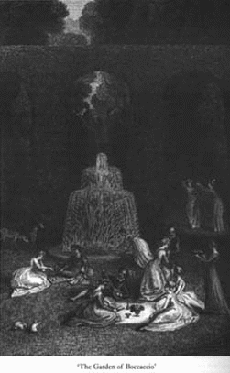
"The Garden of Boccaccio," a Critical Reading
From the outset of the poem, the garden of the Third Day of the Decameron as presented in Stothard's illustration (at right) is viewed by the speaker as an escape from the dreariness of daily life. Coleridge's narrator refers to the "dull continuous ache" (l. 9) he experienced prior to glancing at the illustration placed on his desk; Stothard's plate essentially brings him to Boccaccio's Garden, lifting his spirits and breaking his emotionless monotony. Like the members of the brigata, the speaker finds solace from what ails him in this Garden, "An Idyll, with Boccaccio's spirit warm" (l. 17). This first section of the poem also praises the genius of the order and the structure of the Decameron, which is "framed in the silent poesy of form" (l. 18).
The poem places a great deal of emphasis on the Garden as a passionate and emotional world of the young where the old might find some kind of nostalgic sentiment. Prior to his experience with the Garden, the speaker "Call'd on the Past for thought of glee or grief" (l. 6), longing for some kind of fervent feeling, be it pleasurable or tragic. It is interesting to note that, like the members of the brigata who enjoy tales which are often particularly down-hearted, Coleridge's speaker does not wish away tragedy but accepts it as a way to experience a powerful form of feeling. Having been unable to find this powerful feeling on his own, the speaker uses Boccaccio's Garden as a tool, calling upon "All spirits of power that most had stirr'd my thought / In selfless boyhood, on a new world tost / Of wonder, and in its own fancies lost" (ll. 28-30). He emphasizes a youthful sense of love and the search for a "form for love" (l. 32); this form can be viewed as the practice of storytelling, or as the series of ballads through which the brigata reveals to some extent its own tales of love.
The narrator writes that this youth to which he returns by way of Boccaccio's Garden "...lent a lustre to the earnest scan / of manhood, musing what and whence is man!" (ll. 33-34). The importance of this passage lies in the definition of youth in terms of a kind of search for meaning in life and thus implicitly attributes this search also to the members of the brigata who embody youthful love and pleasure in the Garden. These lines can be viewed as Coleridge's own interpretation of Boccaccio's text beyond its superficial string of stories, or as an indication that he believes there is more to the novellas than the recounting of anecdotes. Later in the poem, with the words "I see no longer! I myself am there, / sit on the ground-sward, and the banquet share" (ll. 64-65), he includes himself and, it can be argued, Boccaccio's general reader as a part of the brigata, experiencing the passions of the Garden and its tales. This connection seems to further emphasize the assertion of lines 33 and 34: the parallel, passionate quests for meaning that belong to the brigata and to the general reader, or Coleridge himself.
Coleridge goes on to juxtapose Philosophy and Poesy as differing forms of a similar concept; he defines Poesy as Philosophy "unconscious of herself" (l. 50), a "faery child" (l. 48) now a "matron ... of sober mien" (l. 46) in the poet's later life. The relationship that Coleridge creates between these two figures contributes to the reading presented here in that it allows the simultaneity of the youthful poesy that he praises in the Decameron and the deeper philosophical implications of the text.
"The Garden of Boccaccio" demonstrates a certain essentialist naturalism which in turn points to Coleridge's philosophical interpretation of the Decameron. He refers to the Garden as a place where "Nature makes her happy home with man" (l. 87). Lines 94 and 95 of the poem, which describe the experience of the Garden as "...the embrace and intertwine / of all with all in gay and twinkling dance," suggest an association of the natural world of Boccaccio's text with a kind of universal or cosmological interaction. This relationship of Nature with man's essential concerns further exposes Coleridge's intent to describe with his poem of praise a philosophical reading of the Decameron.
Coleridge ends the poem with a recognition of several of Boccaccio's sources - Maeonides (Homer) and Ovid, as well as ancient Greek mythology. He depicts the actual figure of "Boccace," kneeling in the Garden and "unfolding on his knees / the new-found roll of old Maeonides" (ll. 97-98), thus placing this continuation of tradition also within the Garden of philosophy and passion. With the words "Long be it mine to con thy mazy page" (l. 102), Coleridge identifies himself with this tradition, and places it upon himself to continue the spirited yet profound naturalism that Boccaccio's Garden and its sources have created.
(S. K.) For additional readings of Coleridge's poem see: Jerome Christensen, "The Associationist Precedent for Coleridge's Late Poems," Philosophical Approaches to Literature: New Essays on Nineteenth and Twentieth Century Texts, Lewisburg: Bucknell University Press, 1984; Susan Luther, "The Lost Garden of Coleridge," The Wordsworth Circle 22.1 (1991): 24-30.